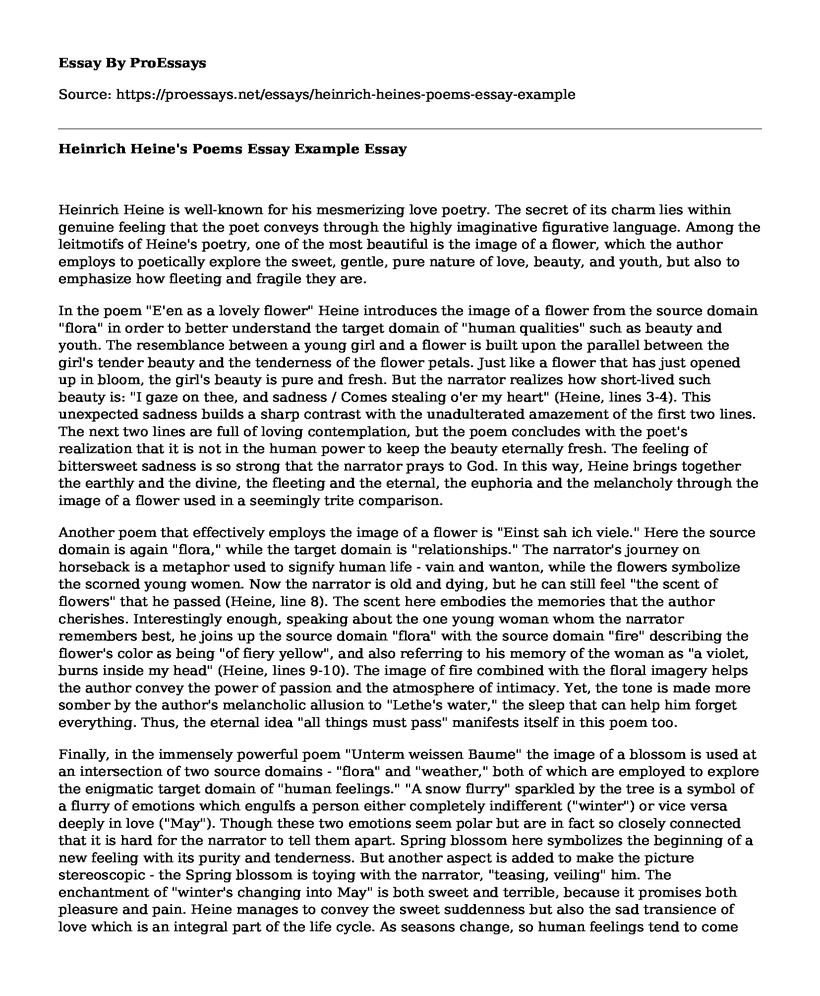Heinrich Heine is well-known for his mesmerizing love poetry. The secret of its charm lies within genuine feeling that the poet conveys through the highly imaginative figurative language. Among the leitmotifs of Heine's poetry, one of the most beautiful is the image of a flower, which the author employs to poetically explore the sweet, gentle, pure nature of love, beauty, and youth, but also to emphasize how fleeting and fragile they are.
In the poem "E'en as a lovely flower" Heine introduces the image of a flower from the source domain "flora" in order to better understand the target domain of "human qualities" such as beauty and youth. The resemblance between a young girl and a flower is built upon the parallel between the girl's tender beauty and the tenderness of the flower petals. Just like a flower that has just opened up in bloom, the girl's beauty is pure and fresh. But the narrator realizes how short-lived such beauty is: "I gaze on thee, and sadness / Comes stealing o'er my heart" (Heine, lines 3-4). This unexpected sadness builds a sharp contrast with the unadulterated amazement of the first two lines. The next two lines are full of loving contemplation, but the poem concludes with the poet's realization that it is not in the human power to keep the beauty eternally fresh. The feeling of bittersweet sadness is so strong that the narrator prays to God. In this way, Heine brings together the earthly and the divine, the fleeting and the eternal, the euphoria and the melancholy through the image of a flower used in a seemingly trite comparison.
Another poem that effectively employs the image of a flower is "Einst sah ich viele." Here the source domain is again "flora," while the target domain is "relationships." The narrator's journey on horseback is a metaphor used to signify human life - vain and wanton, while the flowers symbolize the scorned young women. Now the narrator is old and dying, but he can still feel "the scent of flowers" that he passed (Heine, line 8). The scent here embodies the memories that the author cherishes. Interestingly enough, speaking about the one young woman whom the narrator remembers best, he joins up the source domain "flora" with the source domain "fire" describing the flower's color as being "of fiery yellow", and also referring to his memory of the woman as "a violet, burns inside my head" (Heine, lines 9-10). The image of fire combined with the floral imagery helps the author convey the power of passion and the atmosphere of intimacy. Yet, the tone is made more somber by the author's melancholic allusion to "Lethe's water," the sleep that can help him forget everything. Thus, the eternal idea "all things must pass" manifests itself in this poem too.
Finally, in the immensely powerful poem "Unterm weissen Baume" the image of a blossom is used at an intersection of two source domains - "flora" and "weather," both of which are employed to explore the enigmatic target domain of "human feelings." "A snow flurry" sparkled by the tree is a symbol of a flurry of emotions which engulfs a person either completely indifferent ("winter") or vice versa deeply in love ("May"). Though these two emotions seem polar but are in fact so closely connected that it is hard for the narrator to tell them apart. Spring blossom here symbolizes the beginning of a new feeling with its purity and tenderness. But another aspect is added to make the picture stereoscopic - the Spring blossom is toying with the narrator, "teasing, veiling" him. The enchantment of "winter's changing into May" is both sweet and terrible, because it promises both pleasure and pain. Heine manages to convey the sweet suddenness but also the sad transience of love which is an integral part of the life cycle. As seasons change, so human feelings tend to come and go, and nothing is ever stable.
All in all, in Heinrich Heine's poetry the image of a flower helps the author explore the internal contradiction of beauty, love, and youth which are both fleeting, transient, and also eternal immortalized by the human admiration expressed through poetry.
Word count: 693 words
Works Cited
Heine, Heinrich. E'en as a lovely flower. https://www.poemhunter.com/poem/e-en-as-a-lovely-flower/.
Heine, Heinrich. Selected Poems. https://www.poetryintranslation.com/PITBR /German/Heine.php.
Cite this page
Heinrich Heine's Poems Essay Example. (2022, Jun 06). Retrieved from https://proessays.net/essays/heinrich-heines-poems-essay-example
If you are the original author of this essay and no longer wish to have it published on the ProEssays website, please click below to request its removal:
- Hidden Meaning of Recitatif by Toni Morrison Essay
- Philosophy Response: Brave New World
- The Yellow Wallpaper by Charlotte Gilman and the Bloodline by Ernest Gains Comparative Essay
- Literature Analysis Essay on "Love's Labor's Lost"
- Critical Essay on Another Country: The Interwoven Lives of Eight in the Shadow of Rufus Scott
- Essay on Beloved: A Story of Black Struggles and Triumph in Pre-Civil War America
- Death of a Salesman Idealism and Truth Essay







